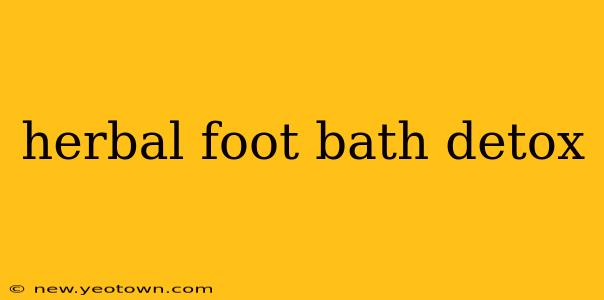For centuries, soaking tired feet in warm water has been a simple pleasure. But add a blend of carefully selected herbs, and you elevate this soothing ritual to a potential herbal foot bath detox. This isn't about a magical cure-all, but rather a relaxing experience with potential benefits for your overall well-being. Let's explore the world of herbal foot baths and uncover what makes them so appealing.
Imagine this: the day is done, your feet are aching, and the scent of calming herbs fills the air. You sink your weary soles into a basin of warm, fragrant water, feeling the tension melt away with each passing minute. This is the essence of an herbal foot bath detox. But what exactly are the benefits, and how can you create your own revitalizing experience?
What are the purported benefits of an herbal foot bath detox?
The purported benefits of herbal foot baths often center around detoxification and relaxation. While scientific evidence supporting significant detoxification through the feet is limited, the ritual offers several potential advantages:
- Relaxation and stress reduction: The warmth of the water and the aromatic herbs can soothe muscles, ease tension, and promote a sense of calm. This is often the most immediate and noticeable benefit.
- Improved circulation: The warm water can dilate blood vessels in the feet, potentially improving circulation throughout the lower extremities.
- Softened skin: The soaking process can help soften calluses and dry skin on the feet. Adding softening herbs like chamomile can enhance this effect.
Does an herbal foot bath detox actually detoxify the body?
This is a question that often arises. The idea of drawing toxins out through the feet is a compelling one, but the science is complex. While the body does eliminate waste products, the skin plays a relatively minor role in this process compared to the liver, kidneys, and lungs. An herbal foot bath might promote relaxation and improved circulation, but it's not a replacement for healthy lifestyle choices and medical treatments.
What herbs are commonly used in herbal foot baths?
Many herbs are associated with potential benefits in a foot bath context. Some popular choices include:
- Epsom salts: Often included, not strictly an herb, but known for its potential to draw out toxins and soothe aching muscles.
- Ginger: Known for its anti-inflammatory properties and potential to improve circulation.
- Chamomile: A soothing herb known for its calming effects and ability to soften skin.
- Lavender: A relaxing and fragrant herb that can promote a sense of calm and tranquility.
- Eucalyptus: Can help clear congestion and soothe irritated skin, making it a potential benefit for those with foot issues.
How do I make an herbal foot bath at home?
Creating an herbal foot bath at home is simple. Fill a basin or tub with comfortably warm water. Add your chosen herbs – either dried or fresh – and Epsom salts if desired. Soak your feet for 20-30 minutes, enjoying the warmth and aroma. After soaking, gently pat your feet dry.
How often should I do an herbal foot bath detox?
There's no set frequency. Listen to your body. If you find it relaxing and beneficial, you can indulge in an herbal foot bath a few times a week. However, if you experience any irritation or discomfort, reduce the frequency or try different herbs.
Are there any contraindications or precautions to consider?
While generally safe, herbal foot baths should be approached cautiously:
- Allergies: Be aware of any allergies you have to herbs before use.
- Open wounds: Avoid foot baths if you have open wounds or cuts on your feet.
- Diabetes: Individuals with diabetes should consult their doctor before using herbal foot baths, as they may have impaired circulation.
- Pregnancy: Pregnant women should consult their doctor before using herbal foot baths to ensure safety.
Ultimately, an herbal foot bath detox is a relaxing ritual with potential benefits for soothing tired feet and promoting a sense of well-being. While it’s not a replacement for medical treatments or healthy lifestyle choices, it can be a delightful addition to your self-care routine. Remember to listen to your body and adjust the frequency and ingredients according to your needs and preferences.

